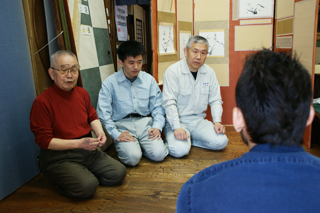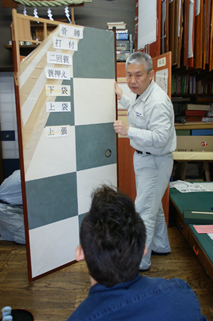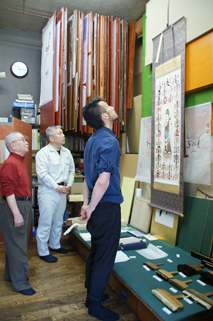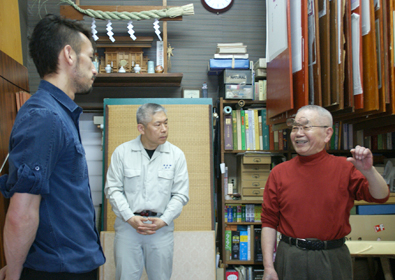4 Generations of “hyogu” experts

”I am happy to be working with my grandson,” Yasoji Maekawa, the 2nd generation of Edo Hyogu which dates back to the Taisho period, told us. A ”kyoji” refers to an artisan that designs and creates scrolls, hanging scrolls, Japanese folding screens and sliding screens. The son, Osamu Maekawa and the grandson have succeeded him as the 4th generation in the line. When Yasoji was young, he experienced an unfortunate tragedy, World War II. There were air raids and Tokyo became a field of burned ruins. People barely survived, with hardly anything to eat. Many of his colleagues looked for jobs elsewhere, but Maekawa decided to continue, following his belief that ”I can earn my living as long as I have glue and a brush.”
”If we can earn people’s trust, demand will increase. That is what I continue to believe and strive for.”
There was a long period where he struggled, but work increased after 7 or 8 years. Maekawa’s patience and sincerity won out in the end.
Century old ”fusuma” (sliding screen) still in use

The ”hyogu” artisan’s tasks are varied. It is said to have originated with covers for Buddhist scrolls. Later when the tokonoma came into existence and ”sado” flourished, it led to demand for covers and designs for ceilings, walls, folding screens, sliding screens as well as restoration work. The world does not end with the completion of a piece, because there is a need for restoration and repairs.
Take the ”fusuma” (sliding screens) for example. They have 11 horizontal frames and 3 vertical. The framework is made by a specialist, then the ”hyogo” artisan is called in. After gluing layers of paper together, there are 6 steps, one of which is called ”minobari”- glue is placed only on the frame and paper, creating a cushion of air which makes it soundproof.
”This method, if done with extra care, can last for 100 years.” There are even those that are 100-200 years old. He recently replaced screens in feudal houses in Shinshu where the screens were 120 years old.
The art of ”kakejiku”

It is the responsibility of the ”hyogu” artisan is ”to make it look good”. In other words, a picture or script is brought in by the client, and the ”hyogu” artisan mounts it. A good example is the ”kakejiku” or hanging screen. First the base made of ”washi” is chosen. ”Our job is to bring out the best features of the picture.” Yasoji stressed.
”I’m sure each customer has their own preferences, but what do you discuss first?” Nakata asked. ”First we ask the purpose. If it is to be used for tea ceremony, Buddhist ceremony or for any other religious purposes, as there are different rules for each. We then take a look at the picture, and the season. Is it spring or is it fall, and suggest using flowers to match the season. Will it be a seasonal flower and water?”
Naturally, the eyes are drawn to the picture itself, but ”kakejiku” is a work of art in its entirety, including how it is displayed. It’s up to the ”hyogu” artisan’s ability to create that ”look”. The dimensions of ”kakejiku” are also based on a history of 1000 years, and brings out the visual appeal. Other than that, minor adjustments are made to fit the picture, which is the main character.
At the end Osamu commented ”The rules that apply to tea ceremonies, Buddhist altars, and hanging scrolls all exist so people do not experience any discomfort. The Japanese culture is a wonderful culture, don’t you agree?



